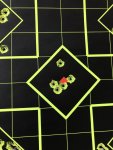Just put on a new ER Shaw barrel for the RPR... Night and day difference over factory barrel. Have about 400 rounds through it today both breaking in and group testing.
Factory barrel shot okay (.6-1" 5 and 10 shot groups and depending on ammo) this is Ruger Factory Barrel after bedding:
Enter ER Shaw barrel....
Highlights:


"Break in" was as follows: clean the crap out of it, then shot one and pull a bore snake for first 3 rounds...then shoot ~50 and pull snake three times. Repeated at ~100 rounds then shot ammo test. Here is setup and break-in target:


Average for first 100 rounds @ 50 yds was .49" using Federal Gold Medal Target (mostly 5 shot groups). 10 shot group also measured .50" exactly.
Here is ammo test:


First three groups of each ammo are 5 shot groups and last is a 10 shot group. Shot at 50yds prone with rear bag and bipod. Super calm conditions until about halfway (Eley Target and lower groups) and wind began drifting left to right slightly. Quarter in middle for reference.
Also, I wasn't happy with the first 10 shot group with FGM Target so I reshot at the very end because something seemed off during first group. It fired a near perfect circle that measured .3" and 10th shot jumped out group by .25". Making it the best 10 shot of the day except for SK Rifle Match.
Bottom line, for $250, this barrel is a major upgrade over stock (at least for me) and for the cost, puts me well within precision needed for long range practice on the cheap.
I put rounds down range at 215yds on a 3" target, hitting 8 of 10 at that range. At 300yds hit 8 of 10 on 6" plate and even 3 of 5 on a 4" plate. If looking for upgrade to an RPR, this is a great starting point. Next it will be the trigger.... Hopefully an update on that subject very soon.
Cheers!
Factory barrel shot okay (.6-1" 5 and 10 shot groups and depending on ammo) this is Ruger Factory Barrel after bedding:
Enter ER Shaw barrel....
Highlights:
- Fits VERY tight into receiver.
- Bolt is very stiff to close but relaxing a bit as surfaces get lapped together.
- Fit and finish is great, especially for the cost ($250).
- Side note: If you have a factory barrel, I would highly recommend removing it to clean up the shitty/nasty/gritty anti-seize they use from factory. My barrel and nut had a ton of sand/grit/dirt like stuff all over and probably didn't allow consistent contact with receiver.
"Break in" was as follows: clean the crap out of it, then shot one and pull a bore snake for first 3 rounds...then shoot ~50 and pull snake three times. Repeated at ~100 rounds then shot ammo test. Here is setup and break-in target:
Average for first 100 rounds @ 50 yds was .49" using Federal Gold Medal Target (mostly 5 shot groups). 10 shot group also measured .50" exactly.
Here is ammo test:
First three groups of each ammo are 5 shot groups and last is a 10 shot group. Shot at 50yds prone with rear bag and bipod. Super calm conditions until about halfway (Eley Target and lower groups) and wind began drifting left to right slightly. Quarter in middle for reference.
- Fed AutoMatch .66" best/.72" avg/ .94" 10 shot
- Fed GM Target .31" best/.64" avg/ *.30"* and .75" 10 shot groups*
- Fed GM HV Match .29" best/.37" avg/ .51" 10 shot
- ELEY Contact .8" best/.84" avg/ .73" 10 shot
- Eley Edge .34" best/.61" avg/.49" 10-shot
- Eley Force .74" best/.61" avg/1.09 10 shot
- Eley Target .37" best/ .56" avg/ .47" 10 shot
- Eley Tenex .35" best/.49" avg/ .53" 10 shot
- SK Std Plus .44" best/ .69" avg/ .66" 10 shot
- SK Rifle Match .27" best/ .44 avg / .36" 10 shot
Also, I wasn't happy with the first 10 shot group with FGM Target so I reshot at the very end because something seemed off during first group. It fired a near perfect circle that measured .3" and 10th shot jumped out group by .25". Making it the best 10 shot of the day except for SK Rifle Match.
Bottom line, for $250, this barrel is a major upgrade over stock (at least for me) and for the cost, puts me well within precision needed for long range practice on the cheap.
I put rounds down range at 215yds on a 3" target, hitting 8 of 10 at that range. At 300yds hit 8 of 10 on 6" plate and even 3 of 5 on a 4" plate. If looking for upgrade to an RPR, this is a great starting point. Next it will be the trigger.... Hopefully an update on that subject very soon.
Cheers!
Last edited:

